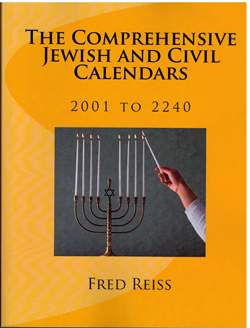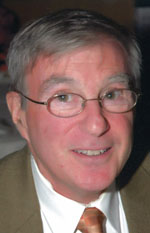By Donald H. Harrison

 SAN DIEGO — Former high school physics teacher Fred Reiss has liked series of numbers since he was a little boy. He recalls that he was approximately six years old when he would stand on the front porch of his aunt’s house in South Philadelphia and count the number of students going to school who would pass by. There were hundreds of them.
SAN DIEGO — Former high school physics teacher Fred Reiss has liked series of numbers since he was a little boy. He recalls that he was approximately six years old when he would stand on the front porch of his aunt’s house in South Philadelphia and count the number of students going to school who would pass by. There were hundreds of them.
Many years later, in 1979, his beloved father-in-law, Ernest Skobeloff, passed away, and when nearly a year had gone by, the funeral home sent a notice telling the date of Skobeloff’s yahrzeit. Reiss, who in the meantime had been teaching himself how to program computers, thought matching Hebrew calendar dates with English calendar dates was an interesting exercise. Eventually, he produced a book of conversions of these dates between the years 1899 and 2050.
Although that calendar still has quite a few years to go, Reiss began thinking about a Jewish tradition, which may be traced to such Talmudic tracts as Rosh Hashanah 31a and Sanhedrin 97a, that the Messiah will arrive in the Hebrew year of 6,000. This corresponds to the secular year of 2240.

For the 223 years remaining before the Messiah allegedly will arrive, Reiss decided to keep track of the corresponding dates of the English and Hebrew calendars. He noted within each year when all the Jewish holidays would fall, as well as all the civil holidays, U.S. federal holidays, and Israeli holidays that will occur between then and now. Additionally, he programmed into his computer all the Shabbat candle lighting times in 18 North American cities with substantial Jewish populations (San Diego is one of them). His new book titled The Comprehensive Jewish and Civil Calendars: 2001 to 2240 will let you easily find a relative’s bar mitzvah or yahrzeit date for more than two centuries into the future.
Had Reiss desired to go beyond 2240, all he would have had to do was punch the numbers 2241 on his keyboard, and the program he devised would have done the work calculating the many variables.
Jewish/civil calendar programming, he told me in a phone interview from his home in Winchester, California, starts with calculating the time for new moon, or molad, of Tishri in one year, and the new moon of Tishri in the following year. The number of days between them gives the length of the Jewish year.
Once you know how many days will be in the Jewish year – according to halacha that number can vary between 353 days and 385 days – everything else falls into place, according to Reiss.
New moons occur on heaven’s own schedule; this is not something that can be changed at the whim of a mathematician. But Jewish law permits the recognition of the new moon’s appearance to be delayed for up to two days if deemed necessary.
For example, explains Reiss, the first of Tishri, which is the date of Rosh Hashanah, cannot occur on a Wednesday or a Friday because the High Holy Days of Rosh Hashanah and Yom Kippur are considered to be like a Shabbat, with all the rules against working on the weekly day of rest applying.
In calculating when Rosh Hashanah should be celebrated, rabbis took into consideration the fact that Yom Kippur occurs exactly ten days later. They deemed it necessary to assure that at least one day separated Shabbat (Saturday) from either Rosh Hashanah or Yom Kippur. If this were not so, observant Jews would be forbidden for two days to cook food or bury the dead, according to halacha.
In addition, Reiss said, the rabbis do not want the holiday of Hoshanah Rabbah, the seventh day of Sukkot, to fall on the Sabbath because the ancient “beating of the willows” ceremony, which is held on that day, is considered work and cannot be performed on the Sabbath. The rabbis assure this will not happen by not permitting Rosh Hashanah to fall on a Sunday.
In programming his calendar, Reiss took into account these and other religious rules, and learned, to his surprise, that whereas the old Julian calendar would repeat itself every 28 years, and the Gregorian calendar took 400 years to repeat itself, the Jewish calendar does not repeat itself for 689,472 years.
The rabbinically computed time for a new moon only repeats three or four times over the 689,472 years, so, “It is safe to say that while calendar structures are the same, no two Jewish calendar years in recorded history have ever been identical,” according to Reiss.
Reiss said one reason for this is the way that the Hebrew calendar divides time. Whereas a day in the English calendar is divided into hours and minutes, the day in a Hebrew calendar is divided into 1,080 parts, according to Reiss.
With the benefit of his computer program, Reiss was able to discover a flaw in calculations by the nine century scholar, Rabbi Nachshon Ben Zadik, who thought he had discovered that Jewish holidays will repeat themselves on the same days every 247 years.
The problem with Ben Zadik’s calculations, Reiss said, is that in each succeeding 247-year period the holidays will occur at a time 905 parts of the day earlier, so “after some number of years, depending on the original molad value, the holiday will not fall on the same day and the rule fails.”
Given that slippage, Reiss also discovered what Ben Zadik did not know about a date in time 3,876 years from today: “Any molad first appearing in or after the Jewish Year 9634 can never follow the 247-year rule.”
Not everyone may have Reiss’s grasp of numbers, but some numbers I think all of can understand is that a book that will be serviceable for 223 years is a bargain at the list price of $17.50, and perhaps even a greater bargain at a discounted price on Amazon.com.
Harrison is editor of San Diego Jewish World. He may be contacted via donald.harrison@sdjewishworld.com